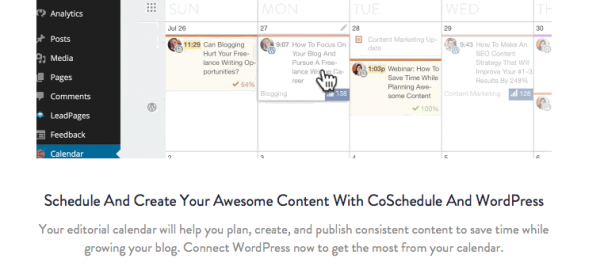When you fail to plan, you plan to fail. This timeless quote from the well-renowned Benjamin Franklin sums up the tough task of getting enough hours out of our day to accomplish our goals. It’s no secret that finding time to blog is a limited resource, which is one of the top 5 marketing challenges for businesses.
Even if you aren’t a business owner, hobby bloggers can find themselves strapped for time. But beyond not having enough hours in a day, it’s also difficult to effectively promote your blog so it can grow to its full potential.
Whether you’re a hobby blogger or a business, planning and promoting is an essential key to blogging success. Effective planning and promotional tools can help add more hours to your day so you can spend more time blogging and less time worrying over your publishing schedule and social media posts.
To get the most out of your blogging, you need a cohesive, all-in-one content planning tool to take your blog to the top—and undoubtedly the best tool on the market is CoSchedule.

CoSchedule: The Secret to Getting Sleep, Writing Your Blog, And Having Time to Spare
Have you ever wondered how successful people seem to have all the time in the world to manage their blog with time to spare? The truth is that they have the same number of hours in a day as you do, but they’ve learned to manage their time extremely efficiently.
When it comes to maximizing your time and getting the most out of your blog, CoSchedule streamlines the process while making you more productive and efficient. Blogging can certainly be a time-consuming process, but CoSchedule is a top-performer for keeping your schedule on track.
But what exactly is CoSchedule, and how does it work?
CoSchedule defines itself as a drag-and-drop content calendar that allows you to plan, publish, and promote your content all from one place. Its competitive edge against other content planners is its ability to combine the Three Ps—planning, publishing, and promoting—into one platform. From there, it integrates posts directly from WordPress or Google Drive so you can update or edit with the click of a button.
Without CoSchedule, both hobby bloggers and businesses will have to use a variety of platforms and resources separately, which takes up tons of time.
These resources include:
- A content calendar created from a place such as Google Drive. Although you can technically use Google Calendar as your publishing planner, it doesn’t offer the features of scheduling and planning content for promotion.
- Bloggers will also need to consider all of their social media platforms that will be used for promotion. There are options on the market to plan and promote blog content, such as Hootsuite, although bloggers will still need to log into a separate platform for scheduling. CoSchedule currently supports Facebook, Twitter, Google+, LinkedIn, Pinterest, Buffer, and Tumblr.
- If you’re working with a team or even just an editor, bloggers will need to consider their communication method for projects. When blogging teams work within CoSchedule’s platform, it cuts out the need of e-mailing back and forth—the team can communicate directly within a scheduled post.
- Furthermore, bloggers will also need to write their post on either WordPress or Google Drive if they are not using Microsoft Word.
- Time is also the last consideration for bloggers as they map out their blogging plan. From brainstorming blog topic ideas to publishing on social media, the minutes add up quicker than you think.
CoSchedule seamlessly combines many of these resources into one cohesive platform. Furthermore, Coschedule also allows you to link directly to the WordPress post or Google Drive document so you can easily access your work. When you’re dedicated to blogging for hobby or business, there’s essentially no other tool you’ll ever need.
Getting Your Feet Wet With CoSchedule: Your 14-Day Free Trial
Now that you clearly understand how CoSchedule works and its amazing ability to integrate time-saving features, it’s time to head over to their website and get familiar with their interface.
If it’s your first time visiting CoSchedule, you’ll be greeted with an eye-catching homepage that invites you to sign up for their 14-day free trial. The good news is that you’re not required to enter any credit card information to get your free trial, which can be a big turn off to potential customers. CoSchedule offers this trial absolutely free, and you only pay if you decide to sign up on a monthly plan—so you won’t be hit with any fees or unexpected payments if you forget to cancel.
The first prompt from CoSchedule that you’ll get after signing up is naming your calendar. You can change the name any time, so don’t fret too much if you don’t pick the perfect name.

Once you have your calendar in place, CoSchedule will ask you if you’re a solo blogger, or if you’re blogging with a team or large company. For the sake of this review, we’ll tell CoSchedule that we’re a solo blogger.

The next step is to connect your WordPress account (if you have one, which is recommended).

Connecting your WordPress account to CoSchedule is super simple, which is one of the many benefits of using this platform in the first place. You’ll enter the URL for your blog and CoSchedule will then prompt you to enter your username and password. CoSchedule should connect your blog within seconds, and you’ll be given instructions to download the plugin onto your WordPress dashboard.
Installing the plugin is also an easy step, even if you haven’t downloaded any plugins before.
CoSchedule gives a simple step-by-step guide that walks you through the entire process. Read more at How do I Install The CoSchedule Plugin?

This is a step that you really do not want to skip, since this is how CoSchedule connects your blog to the platform. It only takes a few minutes to execute and will save you tons of time down the road.
After you’ve finished connecting your WordPress blog to CoSchedule, the next step you’ll tackle is connecting your social networks. CoSchedule supports Facebook, Twitter, Google+, Tumblr, Buffer, and its most recently-added option: Pinterest. You can connect the accounts of your choice through the platform by clicking one of the connect buttons as seen below:

From here, you’ll be taken off of the CoSchedule site with a small popup window. You’ll enter your information and connect CoSchedule to whichever profiles you grant it permission. Keep in mind that this option allows CoSchedule to schedule posts on your behalf—but that’s the good news for you, since the idea is to save you time and hassle of posting on your own.

Now that WordPress and your social media accounts are connected to CoSchedule, you’re ready to dive into your calendar—which is where the fun part begins.
Introduction to CoSchedule’s Dashboard and Calendar
CoSchedule’s dashboard is quite simple and easy to navigate. You’ll see your Calendar Name, a link to the Calendar, your Top Posts, and your Settings Tab. As you can see, the dashboard is very straightforward and easy to use even for the beginner blogger.
Once you start using CoSchedule on a regular basis, you will also see notifications on the main dashboard page. These can consist of messages that other team members send on specific projects. You will also see a list of tasks on the right-hand side that need to be completed, are in progress or are pending on the schedule.
The Settings tab houses numerous integration options, including the aforementioned social media options and WordPress. However, this is also where you can add new team members and guests to collaborate on projects.
You can also make adjustments to the settings of your calendar under the settings tab. This includes changing your calendar name, adjusting your time zone settings, number of weeks to display on the calendar, and even your calendar’s color.
The Top Posts tab is a roundup of your most popular posts sorted by social media popularity. Posts with the highest amount of social shares will be displayed at the top, and the rest follows thereafter. This helps bloggers determine which posts are performing the best, and continuously create similar content to get the most amount of traffic possible.
The calendar tab links you directly to your project calendar, where you’ll have an overview of every blog, scheduled social media posts, and more.

When you first open your calendar, CoSchedule sets up filler content in order to show you the ropes. It’s a placeholder on your blog content calendar where you can begin scheduling posts all on your own. This is a good place to start when you’re starting to learn the ropes within the calendar.
There are 6 key content features that you can add to your calendar:
- Blog posts
- Social messages (stand alone or as part of a campaign)
- Content (eBooks, case studies, press releases, and more)
- Events
- Notes
- Tasks
When you open up the scheduling dashboard, you’ll be introduced to a popup platform where you can:
- Write your title/headline
- Select your content type from the previously mentioned 6 content types (blog post, social message, task, etc).
- Apply a status to your project (e.g. draft, pending, reviewed, scheduled)
- The schedule date and time
- Tasks
- Comments
- Ability to connect a Google Doc or WordPress blog directly within the post
- You can also color code your content on this dashboard to make it easy to sort and organize
Eventually, you can have a calendar that looks like this:

As you can see, there is quite a bit of content scheduled on this calendar. However, it’s extremely easy to edit, adjust, and remove as needed.
In fact, one of the best aspects of CoSchedule is its drag-and-drop feature that makes content planning a snap. You can easily drag and drop scheduled posts and move them around on your calendar to adjust the publishing dates. CoSchedule makes it a no-brainer to create the perfect calendar for your blog, regardless if you’re a solo blogger or you’re managing an entire content marketing team.
The reason that CoSchedule is perhaps the most efficient content planning tool on the market is that everything you need is one place. You don’t have to exit out of the blog publishing dashboard in order to schedule social media posts, blog posts or personally communicate with other people who are involved in the project.
Better Communication, Workflow, and Team Management With CoSchedule
When you post a comment within the dashboard, anyone who is following the content will be notified via email. Once the group is notified, the entire message is delivered within the body of the email. In order to respond, all you need to do is click on the link of the blog post title, or click the red button that says “go to my account.” You’ll then be redirected to the CoSchedule dashboard where you can communicate with your team.
CoSchedule is also highly efficient for those who are managing a large team with a complex workflow. You have the option to manually create tasks within the dashboard and assign them to a specific team member. However, you also have the option to create task templates and assign specific tasks automatically.
Furthermore, you can also create a workflow for a chosen team member so that person is automatically assigned specific tasks that are listed under their designated category. This can relate to graphic designers, content writers, and more. This helps save bloggers and content managers a lot of time when it comes to scheduling assignments.
Igniting Your Social Media Strategy by Using CoSchedule
The CoSchedule calendar dashboard has the option to set up content promotion. In fact, this platform is perfectly engineered to blend content and social promotion together, making your content marketing strategy easier than ever before.
When you’re scheduling a new blog post or other types of content, you’ll see a list of promotion options to choose from. This is where you can schedule your post to be published across social media platforms on the same day, next day, week after publishing, month after publishing, or a custom date.
It’s no secret that promotion is a big piece of the puzzle for getting your content in front of the right audience. KISSMetrics came up with a guide to follow in terms of how often you could promote your content for best results:

To the average blogger, this might seem like a daunting task. Who really has time to post a link on Twitter multiple times a day, and engage readers on 3 more platforms on top of that?
Developing a social media strategy is even one of the top challenges that marketers face with blog and content promotion. It can be difficult to know not only when to publish your blog, but on what social platform and how often.
CoSchedule can help bridge the gap between having audience or readers at all to making a splash in your social media community. The best part is that you can sit down for an hour or so at the beginning of every month and schedule out all of your social posts ahead of time—then your social media strategy is essentially on autopilot.
Best Days and Times to Schedule Blog Posts on WordPress
Did you know that there are certain days and times that is best to schedule your social media posts? Furthermore, there is also a set amount of acceptable social posts to publish each week. See the chart below:

CoSchedule Blog Promotion Guidelines:
Facebook – 5-x10 per week | Best Time – 1-4PM | Worst Time – 8PM-8AM
Twitter – 5x per day | Best Time – 1PM-3PM | Worst Time – 8PM-9AM
Pinterest – 5x per day | Best Time – 2PM-4PM, 8PM-1AM | Worst Time – 5PM-7PM
Google+ – 1-5x per day | Best Time – 9AM-11AM | Worst Time – 6PM-8AM
LinkedIn – 1x per day | Best Time – 7AM-9AM, 5PM-6PM | Worst Time – 10PM-6AM
As you can see, not all social media platforms are created equal. You won’t post as often to LinkedIn as you will on Twitter, and the time of day that you post on each platform can make a big difference in your results. The above chart can help serve as a guide so you can get an idea of exactly when and how often to schedule social media posts on your CoSchedule calendar.
Share Curated Content on Social Media to Maximize Your Reach
If you’ve just started blogging and you don’t have a lot of content to share, that doesn’t mean that your social marketing strategy has to fall flat. CoSchedule can help you maximize your reach by publishing curated content—that way, your social media account will never sit inactive as you continue to craft more blog content.
The idea behind curating content is to share great content from other sources that you think your audience will enjoy. You can mix and max types of content (which is another feature that CoSchedule allows on their platform) to keep things interesting. For example, you can share infographics, videos, slideshows, and eBooks—but you don’t want to find just any content. It needs to be the best of the best.
Another important tip is to consider finding high-quality and helpful content to share that is related to your hobby or niche. You won’t want to stray too far off of your blog’s overall topic or theme, or your customers may become confused or lose interest. Keep in mind that roughly 15% of users will unfollow social media accounts if the content is irrelevant to the theme or brand.
According to Curta, curated content should consist of 25% of your published content. As you’re planning your calendar, keep this percentage in mind to find the right balance. This will help you round out your social media strategy with CoSchedule and make sure that you’re mixing awesome content with your own blog posts every time.
Wondering if there’s an easy way to curate great content? Thanks to CoSchedule’s Google Chrome integration, you can curate content straight from your browser without the need to navigate away. You simply click on the CoSchedule extension button on Chrome and you can grab and share awesome content in seconds.
Enhance Your Social Media Posts With Custom Images on CoSchedule (For Free)
Did you know that social media posts with images generate more engagement? It’s true. In fact, social media updates with images can receive up to an 87% interaction rate from fans.
However, the reality is that we aren’t all graphic designers. And if you’re a hobby blogger, you might not be looking to shell out big bucks in order to get a custom graphic or two. But luckily, that won’t stop you from becoming a social media rock star—and it’s all thanks to Pablo by Buffer.

Pablo is an open source image-editing platform by Buffer. You can choose from a series of images and publish custom text directly on the photo. Pablo allows you to add custom effects, adjust the image size and even select a template that will fit perfectly with Facebook, Twitter, Instagram, or Pinterest.
Pablo is perfect for beginner bloggers (or even seasoned bloggers without graphic design skills) for several reasons. First, the idea is that you can create custom images on this platform in 30 seconds. It’s quick and efficient, just like CoSchedule.
Second, since you can integrate Buffer with CoSchedule, you can post your Pablo images directly from CoSchedule’s platform. This makes it ultra easy to share your content on CoSchedule from Buffer in just a couple clicks of a button.
Best of all, using Pablo doesn’t cost a dime. When you’re done, you simply hit the “download image” button and the photo is saved directly to your computer.
Easy, right?
Simplify Your Content Planning and Calendar With CoSchedule
If you’re a beginner blogger or you’re just looking for a way to enhance your content calendar, CoSchedule hits the mark on nearly all levels. You simply can’t find a more cohesive content planning system that integrates with WordPress and provides an abundance of bells and whistles.
![]()
No matter what social platform or organizational tool that you use, there’s something for every blogger on CoSchedule. It has over a dozen integration features, and every one of them is able to help your blog stay on its publishing schedule, promote top-notch content, and even help generate more traffic. What do you have to lose by signing up for a 14-day free trial?
After you get yourself set up with CoSchedule, don’t forget to check out Buffer and their awesome open source social media image software Pablo. Once you collaborate all of the innovative features that CoSchedule has to offer, your blog will become virtually unstoppable.
Have you tried CoSchedule before? Did you find our review helpful? Let us know what you think in the comments below!
Digital & Social Articles on Business 2 Community(103)
Report Post






